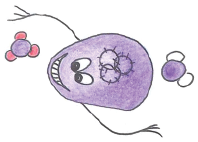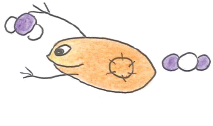Team:DTU-Denmark/Experiments
From 2013.igem.org
(→Production of nitrous oxide (N2O) from nitrite (NO2- ) under anaerobic conditions) |
(→Mutant 1: Aerobic consumption of ammonium and hydroxylamine) |
||
| (28 intermediate revisions not shown) | |||
| Line 1: | Line 1: | ||
{{:Team:DTU-Denmark/Templates/StartPage|Experiments}} | {{:Team:DTU-Denmark/Templates/StartPage|Experiments}} | ||
| - | + | == Initial Characterization of ''E. coli'' == | |
| - | + | ||
| - | + | ||
| - | + | Initially, we did two experiments to characterize untransformed ''E. coli'' under conditions that would be present during wastewater treatment. | |
| - | + | ||
| - | + | ||
| - | + | === Toxicity of Nitrite, Nitrate and Ammonium to ''E. coli'' === | |
| + | The purpose of this experiment was to determine whether the ions nitrite, nitrate and ammonium are toxic to ''E. coli'', and at what concentration. We used the [http://www.m2p-labs.com/biolector-gbl100 BioLector] microfermentation system to grow an ''E. coli'' strain that constitutively expresses RFP in the presence of these ions (at a range of concentrations), and measured the fluorescence of the cells and light scattering (proportional to optical density) as a proxy for growth. We found that high concentrations ammonium (≥500mM) and nitrate (≥25mM) were toxic to ''E. coli''. However, these concentrations are much higher than we would expect to find in wastewater, so we do not expect these ions to be toxic to our cells under normal operating conditions. | ||
| - | + | [[Team:DTU-Denmark/ToxicityExperiment|Experiment details -- Toxicity of Nitrite, Nitrate and Ammonium to ''E. coli'']] | |
| - | + | ||
| - | + | === Nitrite stability in anaerobic ''E. coli'' === | |
| - | + | To measure how much nitrite would be consumed by competing pathways (such as conversion to ammonia) in Mutant 2, we grew untransformed ''E. coli'' anaerobically in the presence of nitrite and measured the amount of ammonia and nitrite present. We found that a pathway to convert nitrite to ammonium was active, and therefore our Nir pathway will need to outcompete this pathway. | |
| - | + | [[Team:DTU-Denmark/Experiment1a|Experiment details -- Nitrite stability in anaerobic ''E. coli'']] | |
| - | + | == Verification of Transformants == | |
| - | + | In order to verify and characterize our Mutant 1 (grows under aerobic conditions; converts ammonia → nitrite) and Mutant 2 (grows under anaerobic conditions; converts nitrite → nitrous oxide) transformants, we performed the following experiments. | |
| - | |||
| - | [[ | + | === Mutant 1: Aerobic consumption of ammonia and hydroxylamine === |
| + | [[File:Dtu-Mutant1.png|right]] | ||
| + | Grow Mutant 1 AMO and HAO transformants aerobically in the presence of ammonia and hydroxylamine respectively. We found that the AMO transformant used ammonia more quickly than a nontransformed ''E. coli'' control, suggesting that the AMO is functional and active. We also found that hydroxylamine was toxic to the cells, and did not detect nitrite production in our HAO transformant. | ||
| - | + | [[Team:DTU-Denmark/Experiment4|Experiment details -- Aerobic consumption of ammonium and hydroxylamine]] | |
| - | Grow | + | === Mutant 2: Anaerobic production of nitrous oxide from nitrite === |
| + | [[File:dtu-Mutant2-extra_ws.png|right]] | ||
| + | Grow our transformed Mutant 2 anaerobically in the presence of varying concentrations of nitrite; measure the amount of nitrous oxide produced. Controls are untransformed ''E. coli'' and ''P. aeruginosa''. The results from this experiment are complicated by the fact that measurements of nitrous oxide are extremely sensitive and the sensors did not always give reliable data. | ||
| - | [[Team:DTU-Denmark/ | + | [[Team:DTU-Denmark/Experiment2|Experiment details -- Anaerobic production of nitrous oxide from nitrite]] |
| - | == | + | == Bioreactor == |
| + | |||
| + | Finally, in order to see if the long term behaviour of our Nir transformant, we grew it in a bioreactor. | ||
| - | [[Team:DTU-Denmark/Bioreactor|Bioreactor]] | + | [[Team:DTU-Denmark/Bioreactor|Experiment details -- Growth of Nir transformant in Bioreactor ]] |
{{:Team:DTU-Denmark/Templates/EndPage}} | {{:Team:DTU-Denmark/Templates/EndPage}} | ||
Latest revision as of 12:34, 4 October 2013
Experiments
Contents |
Initial Characterization of E. coli
Initially, we did two experiments to characterize untransformed E. coli under conditions that would be present during wastewater treatment.
Toxicity of Nitrite, Nitrate and Ammonium to E. coli
The purpose of this experiment was to determine whether the ions nitrite, nitrate and ammonium are toxic to E. coli, and at what concentration. We used the [http://www.m2p-labs.com/biolector-gbl100 BioLector] microfermentation system to grow an E. coli strain that constitutively expresses RFP in the presence of these ions (at a range of concentrations), and measured the fluorescence of the cells and light scattering (proportional to optical density) as a proxy for growth. We found that high concentrations ammonium (≥500mM) and nitrate (≥25mM) were toxic to E. coli. However, these concentrations are much higher than we would expect to find in wastewater, so we do not expect these ions to be toxic to our cells under normal operating conditions.
Experiment details -- Toxicity of Nitrite, Nitrate and Ammonium to E. coli
Nitrite stability in anaerobic E. coli
To measure how much nitrite would be consumed by competing pathways (such as conversion to ammonia) in Mutant 2, we grew untransformed E. coli anaerobically in the presence of nitrite and measured the amount of ammonia and nitrite present. We found that a pathway to convert nitrite to ammonium was active, and therefore our Nir pathway will need to outcompete this pathway.
Experiment details -- Nitrite stability in anaerobic E. coli
Verification of Transformants
In order to verify and characterize our Mutant 1 (grows under aerobic conditions; converts ammonia → nitrite) and Mutant 2 (grows under anaerobic conditions; converts nitrite → nitrous oxide) transformants, we performed the following experiments.
Mutant 1: Aerobic consumption of ammonia and hydroxylamine
Grow Mutant 1 AMO and HAO transformants aerobically in the presence of ammonia and hydroxylamine respectively. We found that the AMO transformant used ammonia more quickly than a nontransformed E. coli control, suggesting that the AMO is functional and active. We also found that hydroxylamine was toxic to the cells, and did not detect nitrite production in our HAO transformant.
Experiment details -- Aerobic consumption of ammonium and hydroxylamine
Mutant 2: Anaerobic production of nitrous oxide from nitrite
Grow our transformed Mutant 2 anaerobically in the presence of varying concentrations of nitrite; measure the amount of nitrous oxide produced. Controls are untransformed E. coli and P. aeruginosa. The results from this experiment are complicated by the fact that measurements of nitrous oxide are extremely sensitive and the sensors did not always give reliable data.
Experiment details -- Anaerobic production of nitrous oxide from nitrite
Bioreactor
Finally, in order to see if the long term behaviour of our Nir transformant, we grew it in a bioreactor.
Experiment details -- Growth of Nir transformant in Bioreactor
 "
"






